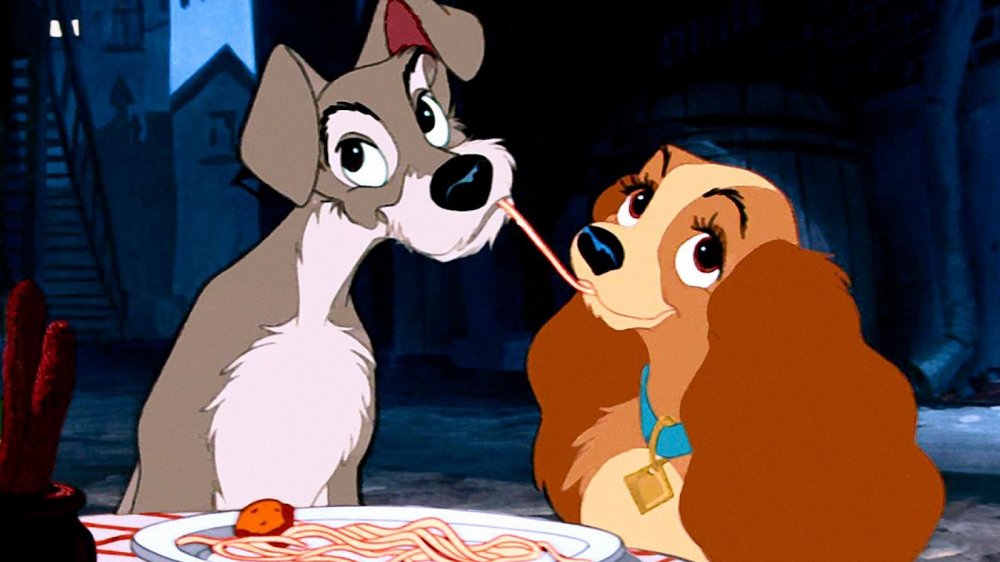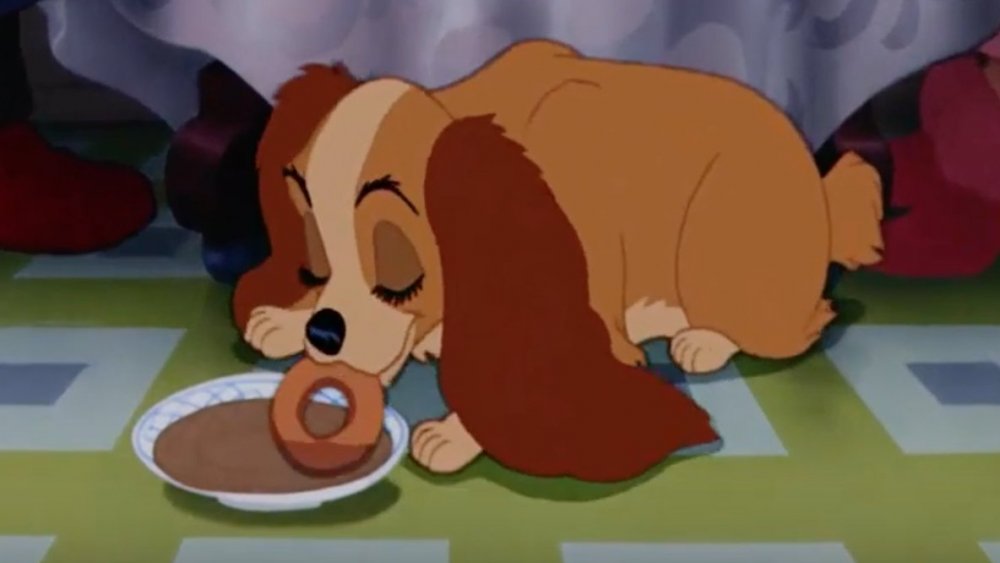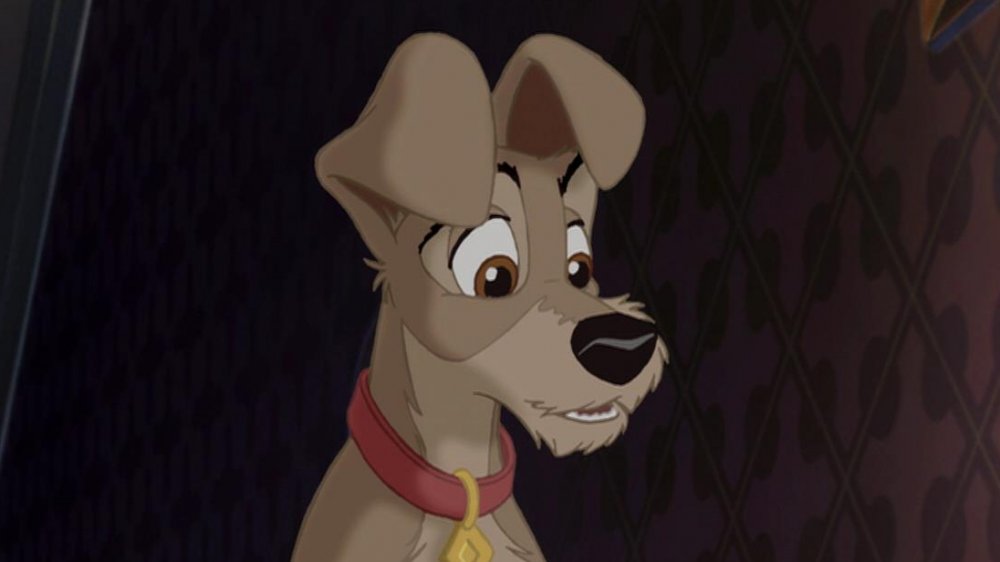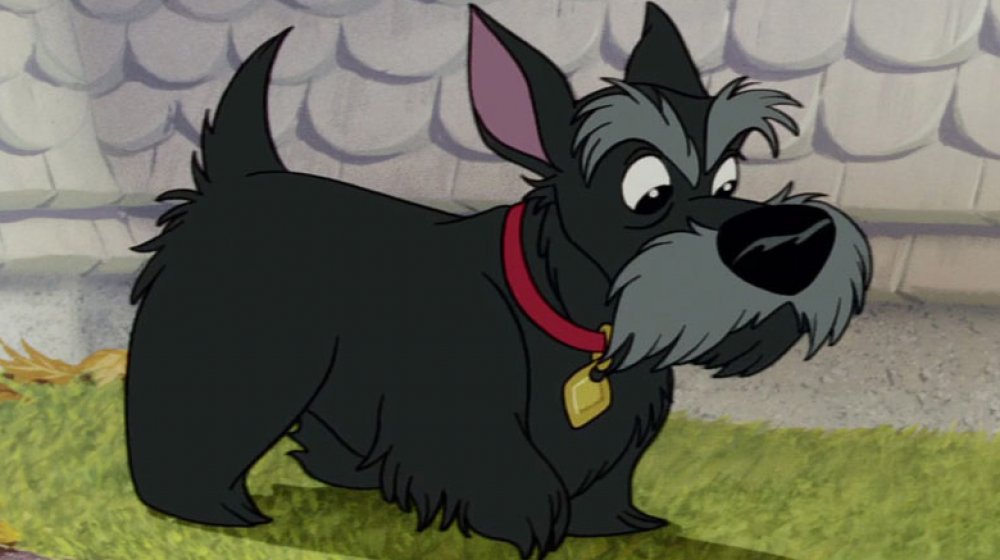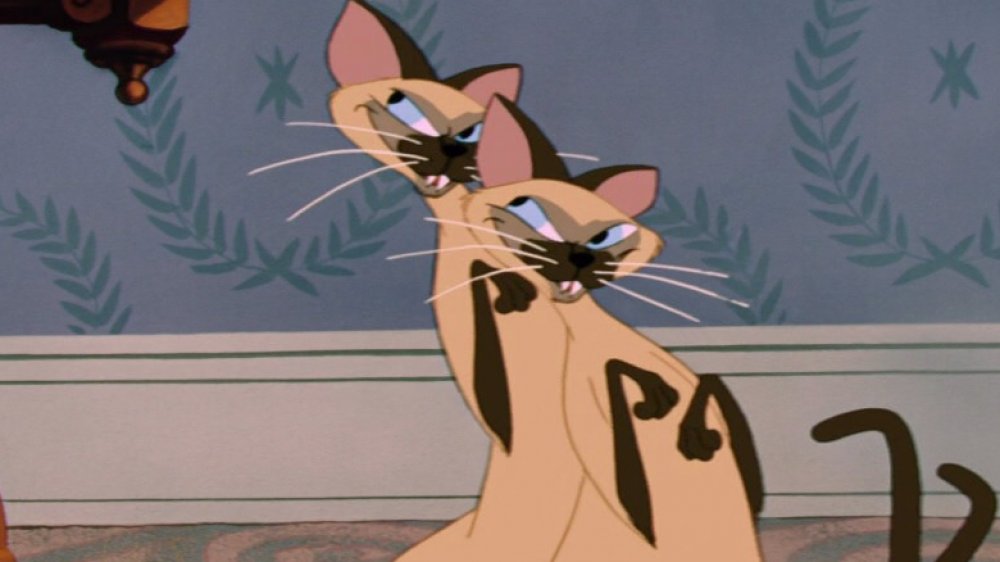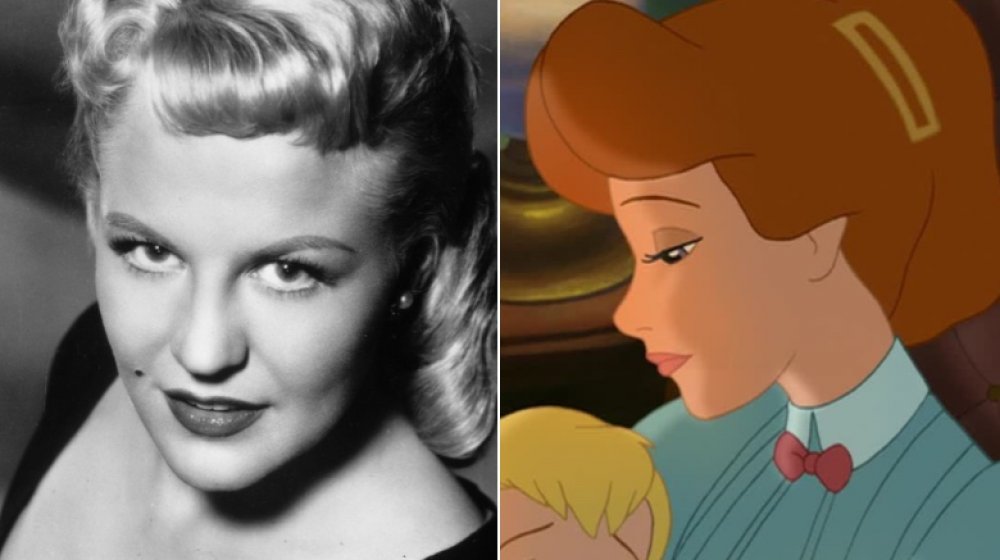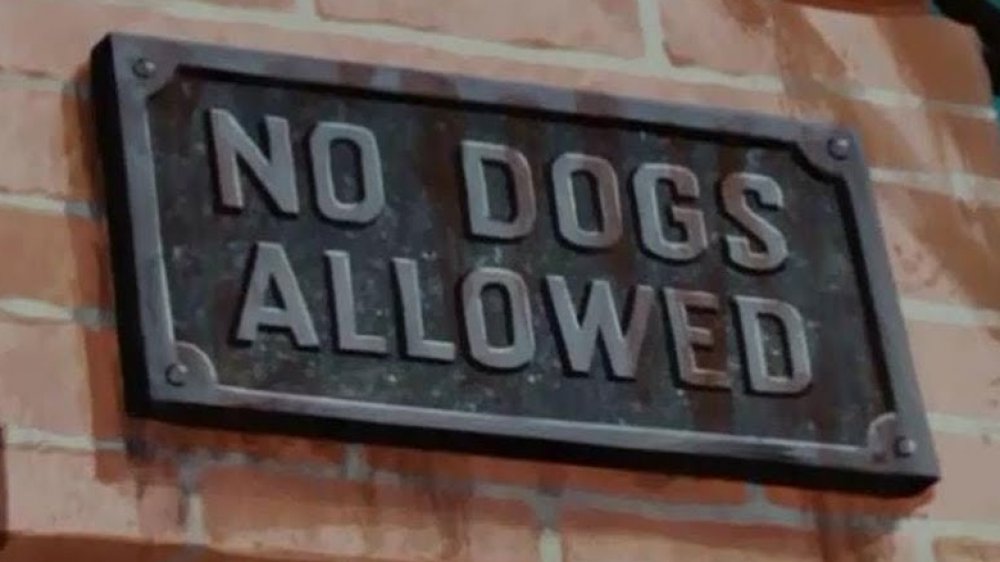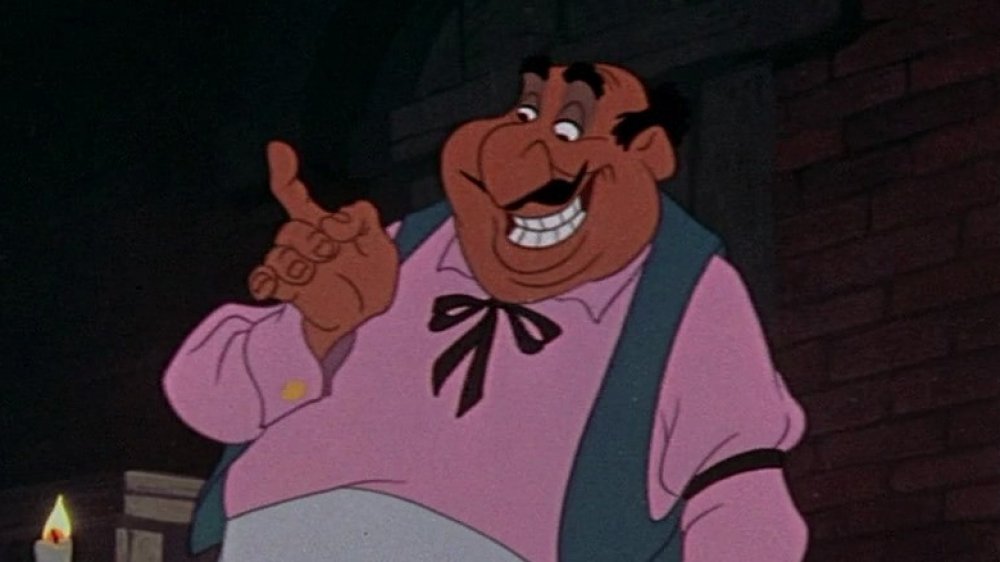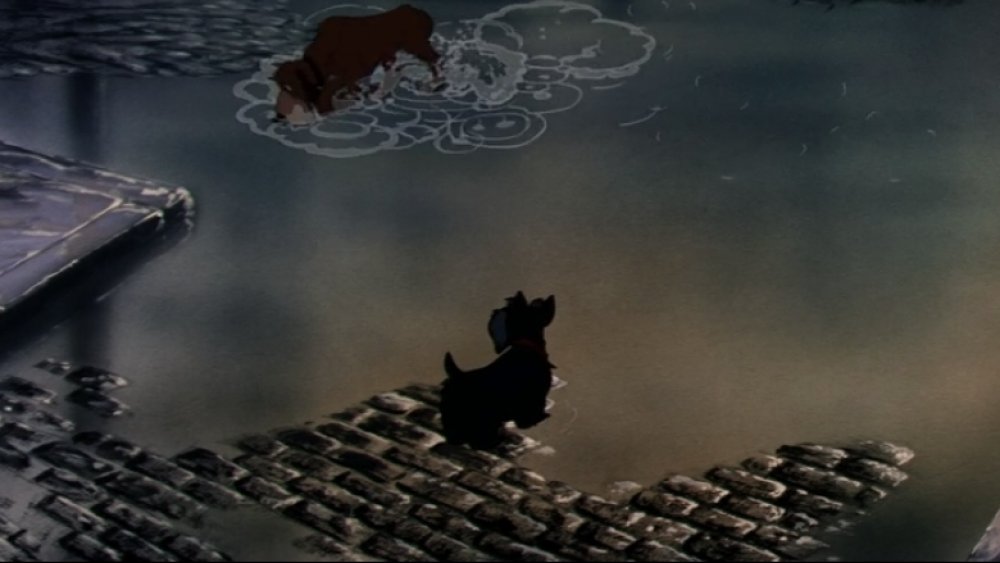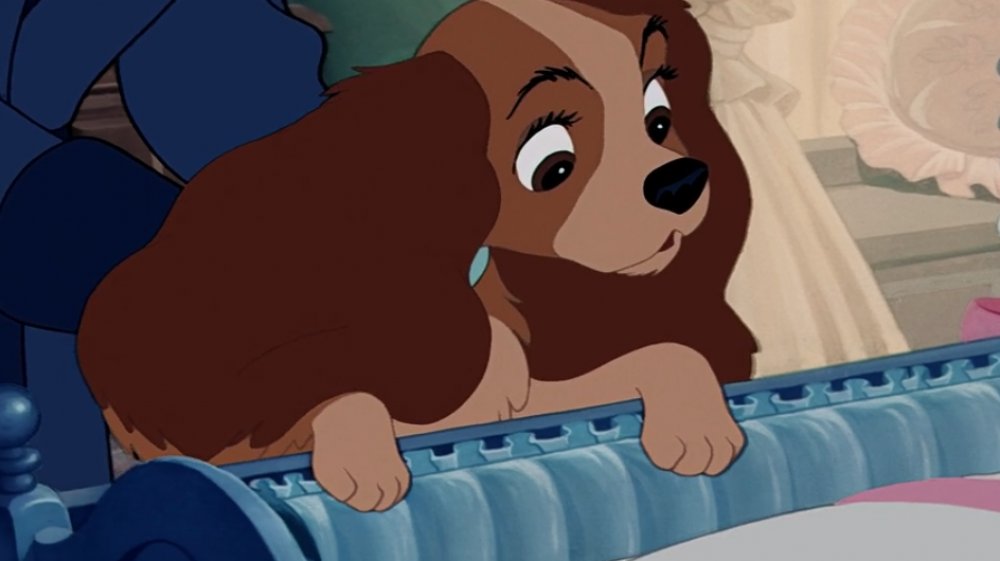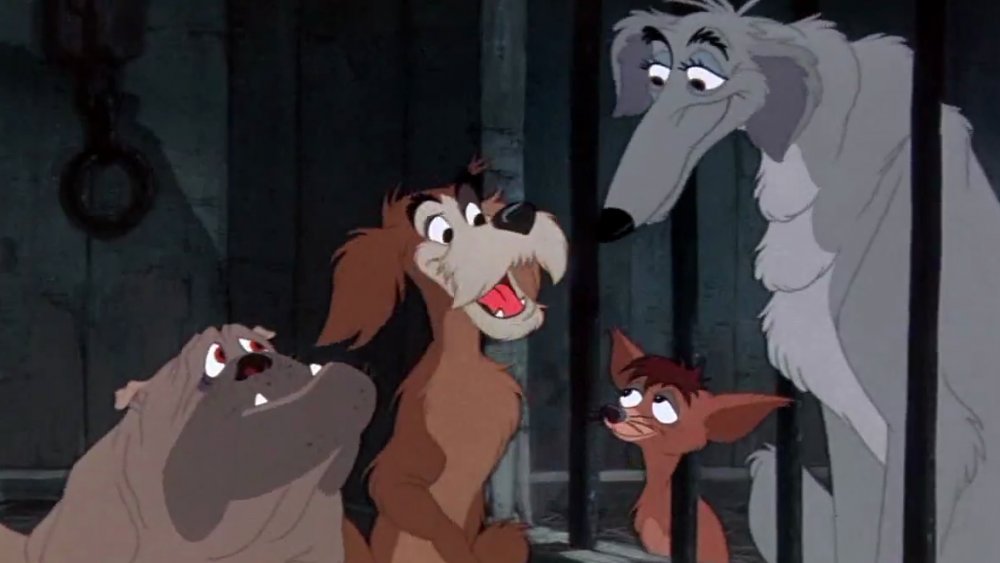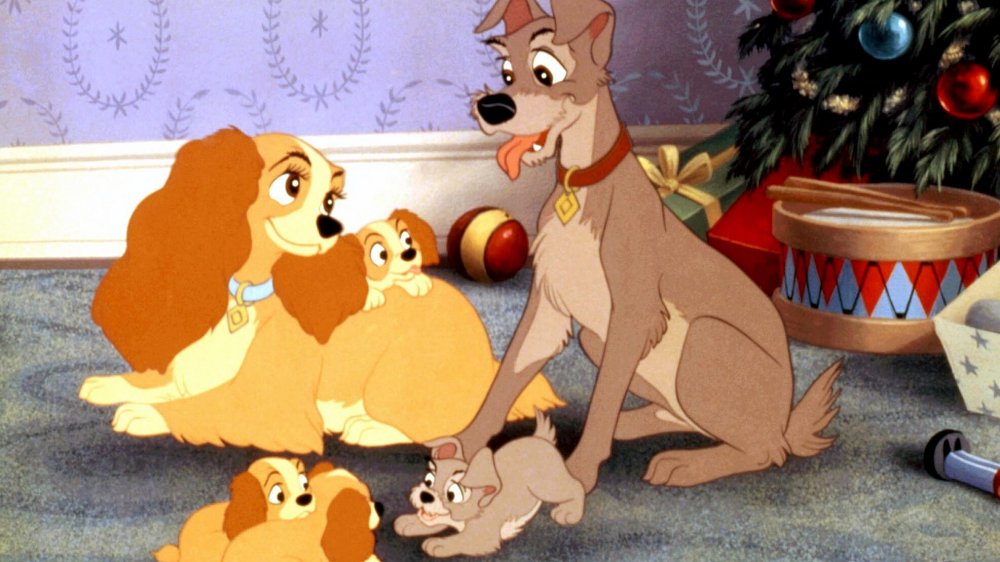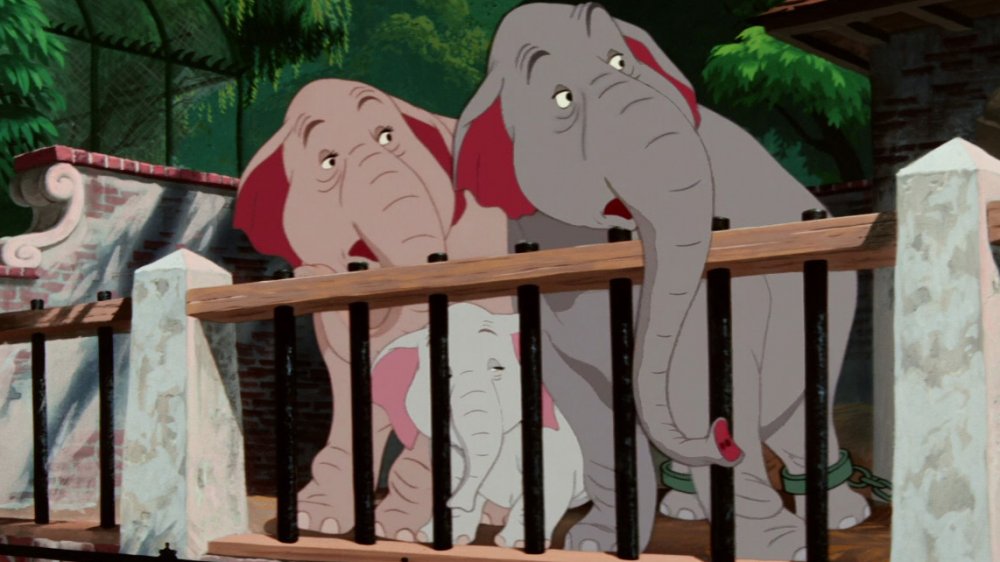Things Only Adults Notice In Lady And The Tramp
Lady and the Tramp is an animated movie, it's a movie about dogs, and yet it's also one of the first romance movies that millions will ever watch, detailing the meeting, romance, and happy ending for Lady, a fancy cockier spaniel from an upper crust home, and a dog known primarily as the Tramp, a guy on the move with no fixed address who goes wherever the spirit of adventure (or empty stomach) takes him.
Released by the Walt Disney Company in 1955, Lady and the Tramp has become one of the studio's most timeless and well-liked films, a blockbuster that's lived for decades and enchanted multiple generations with its big cast of adorable, rascally dogs and a message that love can conquer all. There's also a lot going on beneath the surface — Lady and the Tramp has a lot to say, and some of those messages are noticed only by the adults watching along with their kids. Here are some things in Lady and the Tramp that children probably won't even notice, but will get the full attention of grown-ups.
Lady and the Tramp has some odd ideas about raising dogs
Common knowledge evolves over time, and Lady and the Tramp offers a fascinating look at how Americans train and treat their pets has radically changed. The movie opens on Christmas, when Jim Dear gifts Darling a new puppy, who is immediately named Lady. Then, just a couple of seconds later, the bonding ends and the baby dog is placed in a dark kitchen by herself with a newspaper laid out in case she needs to relieve herself. Jim Dear seems to think Lady will just know exactly how to behave in this situation full of new experiences and gets mad and yells at her when she won't stop barking because she's clearly afraid and unsure — as if a puppy will know what "be quiet!" shouted down from the ceiling means. Eventually, Lady gets her way and snuggles into bed with Jim Dear and Darling, and the move jumps ahead in time. Lady is still sleeping on the comfortable bed at night, while the humans have gone completely the other way — from strict to lackadaisical — on dog treatment. They feed Lady what appears to be her usual, or most favorite breakfast: a donut along with a saucer of hot coffee.
Lady and the Tramp is full of weird names
The naming conventions of Lady and the Tramp may seem a little odd to older, more sophisticated viewers, but they do make sense within the context of the film. Most of the main dog characters accept as their names the ones bestowed upon them by their human caretakers. Lady, for example, calls herself Lady, because that's what the female human she lives with names her upon receiving her as a Christmas present. That woman, curiously, is only ever referred to as "Darling."
Because Lady and the Tramp is told from the point of view of dogs, Lady assumes Darling is her owner's name, because that's the only thing she ever hears anybody use. That's the term of endearment used by Darling's husband, who is similarly referred to only by a pet name: Jim Dear. When Lady meets her de facto dog husband, the naming system gets weird again. The title of the movie affords a real name to just Lady, while her male counterpart is referred to by his station in life: "The Tramp." He goes by a number of names — Butch and Mike, depending on the party addressing him — although he doesn't call Lady by her name, but rather quickly adopts nicknames like "Pigeon" and "Kid," both of which are a bit odd and juvenile for one to use on their supposed true love.
How to tell when Lady and the Tramp takes place
There are many contextual clues in Lady and the Tramp that indicate when in time, exactly, it takes place. Adults with at least a passing knowledge of history and some observational skills can figure out that it takes place very early in the 20th century, because of the style of clothes worn by the human characters (billowy dresses for Darling), architecture (palatial homes evocative of Southern plantation houses of the late 1800s), and cultural references (an old playbill advertising Uncle Tom's Cabin, a major literary work of the Civil War era).
The variety of backgrounds is another nod toward the historical context of Lady and the Tramp. The late 19th and early 20th centuries witnessed a massive immigration boom to the United States, as large swaths of people from throughout Europe moved to America in hopes of social freedom and economic opportunity. This is reflected in the diversity of characters in Lady and the Tramp, although many are depicted as little more than broad cultural stereotypes. For example, Lady is friends with a Scottish terrier named Jock who speaks in a thick Scottish brogue and uses many Scottish colloquialisms, while the Tramp creates a diversion outside the zoo with a cliched Irish policeman, complete with red hair and Irish accent. Butch later tells Lady about his food sources, which include the traditional German cooking of a German family, and the traditional Irish cooking at the "O'Brien" house.
Those Siamese cats didn't age well
While Lady and the Tramp uses some broad, awkward stereotyping for Irish and Scottish characters, the way it depicts two Siamese cats is downright racist, and shockingly so. Parents watching this movie in the present day will likely be surprised that such content was ever considered okay. It's so blatantly awful that Disney+ added a disclaimer to the film, which warns that the film "may contain outdated cultural depictions." That's putting it lightly.
Si and Am, Aunt Sarah's mischievous cats that attack a goldfish and get Lady in trouble, are presented in the way Asian characters often were in the early-to-mid-20th century. Their accents are cartoonishly exaggerated, and they speak in broken English, freely mixing up "l" sounds with "r" sounds. All the while they're underscored by "We Are Siamese," a song comprised of stereotypical, pseudo-exotic, and "Asian" motifs. As if that wasn't bad enough, both Si and Am have big buck teeth, a caricature of Asian people widely used in films in the mid-1900s.
Miss Peggy Lee, anyone?
It's common practice for present-day animated films to hire big-name actors and musicians to voice their casts of characters. When a movie like Onward touts the involvement of unseen stars like Chris Pratt and Tom Holland, it's basically a marketing gimmick to get parents to take their kids to see the movie or rent the video. After all, what four-year-old really cares that the immersive cartoon they're watching has characters voiced by people from that movie or TV show their parents like?
Famous celebrities acting in animated features is nothing new, and it dates back at least to 1955, when Lady and the Tramp hit theaters. Headlining the cast: Miss Peggy Lee, an extremely popular American singer in the vocal jazz and traditional pop styles in the pre-rock n' roll era. Lee lent her voice, with which mainstream audiences were extremely familiar in 1955, to the voices of human Darling and the cats Si and Am, and also helped write six songs on the film's soundtrack. Adults who saw Lady and the Tramp during its initial release must have enjoyed or at least appreciated Lee's contributions, while grown-ups who watch it now would at least be more familiar than their kids are with the legendary singer of "Fever," "Mañana," and "Big Spender."
The dogs in Lady and the Tramp can read
Lady, a cocker spaniel from a well-appointed home, and the Tramp, a dog beholden to no man proud of his wandering ways and freedom, don't have a whole lot in common, but they do rank among the greater, at-large community of dogs. They both apparently speak the same language — English, as Lady and the Tramp viewers are to understand — while also seeming to be in the possession of a tremendously impressive skill not afforded real-world dogs. Lady, as well as the Tramp, are able to read.
This is something that has to be learned and cultivated, and it's unclear how, in the less than one year she's been alive, that Lady acquired that ability, and viewers similarly don't know where the Tramp picked it up. But keen-eyed adults will notice that Lady and the Tramp's action is propelled forward because these dogs ascertain information about their surroundings by reading signs. For example, during their citywide excursion together, the Tramp takes Lady to a zoo to get her muzzle removed, which perplexes her, because she sees a "no dogs allowed" sign. Earlier in the film, the Tramp tries to lay low after reading a posted notice warning pooches that they will be seized by a dogcatcher if they are unclaimed and unaccompanied — as if the bill was placed for stray dogs like him to see in the first place.
That's not a great restaurant
Even people who haven't even seen Lady and the Tramp are familiar with one scene in the animated classic — it's just that iconic of a sequence. Shortly after they meet, the tramp named Tramp shows the classy Lady around town, and introduces her to his way of life, which includes charming his way into meals. They wind up at Tony's, a small restaurant that appears to be a traditional, small Italian bistro, but grown-up viewers will realize that this eatery is anything but normal.
First of all, it's dinner time, as the Tramp notes, and yet Tony's is completely empty. There don't appear to be any customers, and the staff, stereotypical Italian cooks Tony and Joe, thusly have nothing to do in the quiet kitchen. That enables them to run around and eagerly prepare a meal for Tramp (and his date) as if he's a honored guest or big tipper, and not just some random dog off the street they see now and then. The humans serve the dogs a massive platter of spaghetti and meatballs, which, unlike real dogs, they take their time to eat, slurping up noodles that ends in a kiss and flirtatiously rolling meatballs around. Actual dogs would have scarfed it all down in about five seconds and wouldn't have shared, and actual restaurateurs who didn't want to get shut down by the health department would never so openly welcome animals into the establishment.
Lady and the Tramp: after dark
Lady and the Tramp contains a scene of lovemaking among two consenting, full-grown dogs. It's not graphically depicted, owing to a number of factors, such as how the film was produced in the socially conservative 1950s, and that it's a Disney movie geared toward an audience of children. The scene where Lady and the Tramp do a very adult thing in this kids' movie is full of implication and obfuscation, but it's obvious to all but the youngest and most unsophisticated viewers. After their very special date, in which they learn all about each other and share the most intimate spaghetti dinner in cinematic history, the dogs retire to a field overlooking the city. It gets dark, and a singer on the soundtrack warbles that "this is the night." This is the night indeed — the action fades to black, and grown-up viewers know exactly what happens next.
In the morning, Lady wakes up with a start, more than a little embarrassed that she allowed herself to stay out all night with a virtual stranger — a drifter at that. It's not too long after that encounter that Lady realizes she's pregnant.
Lady and the Tramp gets real about pregnancy
Well before Lady gets pregnant with puppies, another character in Lady and the Tramp is expecting: Darling. Lady doesn't understand this very normal thing at first, and younger viewers might not either. Lady overhears the humans referring to her with the anti-canine epithet "that dog" and is temporarily banished from some of the more comfortable areas of Darling and Jim Dear's home, because of, she presumes, some bad thing she didn't even know she did. It's so bad that Darling won't even take her for a walk. Actually, her dog friends tell her, all this behavior is because Darling is with child, and humans get very territorial, careful, and exhausted when they're in such a state. (Because Lady and the Tramp is a film from the 1950s, the word "pregnant" amazingly doesn't actually appear in the dialogue, but rather euphemistic phrases instead, so as to not offend the delicate sensibilities of the era.)
The movie depicts another true-to-life pregnancy symptom that only adults, and particularly adults who have been through pregnancy or lived with someone who went through pregnancy, can truly appreciate. Women growing a child in their bodies can often experience bizarre and powerful cravings that simply must be satisfied — shown here when Darling sends Jim Dear out into a snowstorm to procure the amusing combination of watermelon and chop suey.
Death looms large in Lady and the Tramp
As is the case in a lot of old cartoons about dogs, dogcatchers are a looming source of worry for the canine characters in Lady and the Tramp. As they should — animal control lurks in the shadows and can strike at a moment's notice, when a dog lets their guard down. Lady and the Tramp and other kid stuff equates a dogcatcher with a dog's loss of freedom — they're essentially police who lock up dogs for being unlicensed and homeless and send them to the pound, or prison. What's unspoken about pounds is ascertained only by older, savvier viewers: they often mean death. Kid viewers, or at least sheltered ones, likely aren't aware that there are animal repositories besides "no kill shelters" and that such places were at one point the only kind of place where unclaimed dogs were kept. Lady and the Tramp finds Lady confronting the concept head-on when she spends the night in a pound, where all the dogs in the know fear "the long walk," the euphemistic name for the one-way trip to the euthanasia room.
Will Lady and the Tramp live happily ever after?
Broken down into its most basic tropes, Lady and the Tramp is a love story, and one about a mismatched couple at that. After all, opposites attract, and Lady and the Tramp are about as different as two dogs can be — yet grown-ups watching the movie may be mature and world-weary enough to know that this could be a destructive notion, and not a romantic one, as is presented. Lady enjoys her comfortable, even pampered life in the home of Jim Dear and Darling, eschewing the life of uncertainty and scrappiness that the Tramp champions. She prefers what he calls "life on a leash," and he likes having a different home "for every day of the week" because it allows him the freedom to roam. Sure, he settles down with Lady once she gives birth to his puppies, but he's likely to feel that familiar itch of wanderlust and bristle at Lady's way of life before long. Older viewers of Lady and the Tramp just might notice that a breakup over a fundamental difference in life philosophy could be brewing between these two cartoon dogs.
Disney references abound in Lady and the Tramp
Lady and the Tramp ranks among the canon of Disney animated classics, only the 15th full-length cartoon feature released by the studio. It of course has that Disney look and feel, and older viewers well-versed in the language of the House of Mouse might be more apt to notice references to some of the animation giant's previously produced big-screen works. Making a feature-length animation project is expensive, and Disney necessarily cut a few corners when it could. Take the scene when a bunch of unfamiliar dogs chase Lady and angrily bark at her: The stock sound of dogs barking is the same as the one used when hounds chase Bambi and Faline in 1942's Bambi. And when the Tramp takes Lady to the zoo to look for a way to remove her constrictive muzzle, some judgmental elephants look on at the dogs. Those elephants strongly resemble (and share a similar life behind bars) to those of the 1941 Disney film Dumbo.
